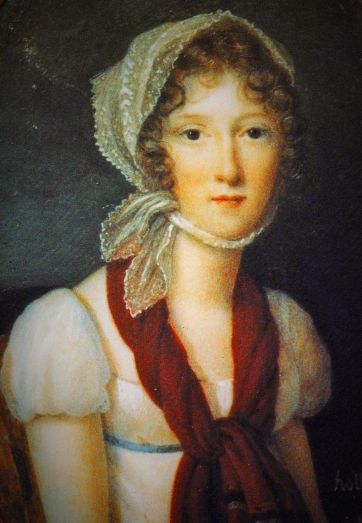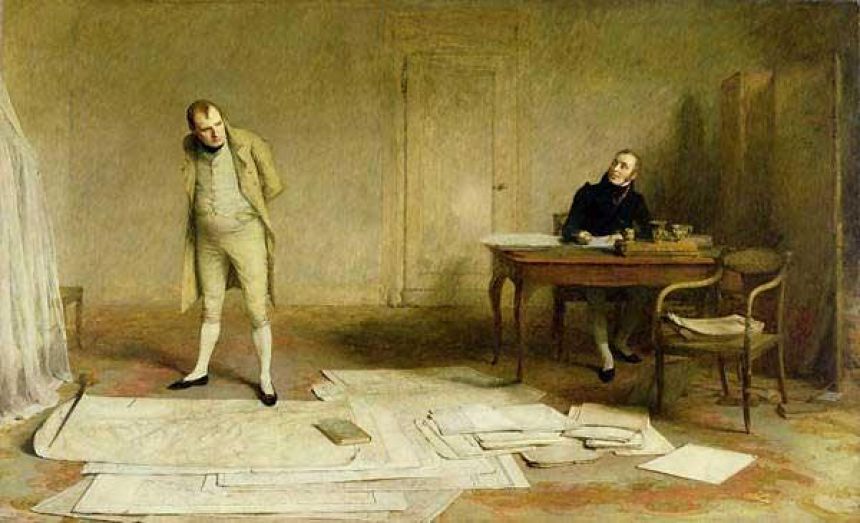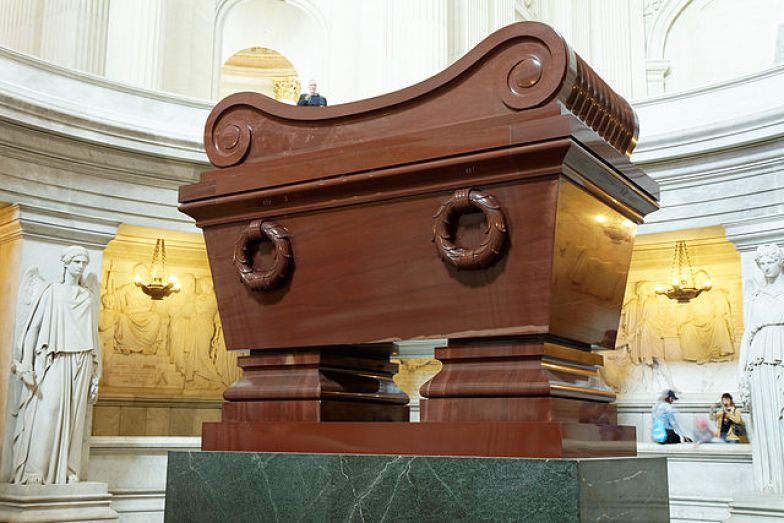Napoleon on St Helena
Kit Power

Kit Power
"My death is penetrating: I have been assassinated by the English ….... and their hired murderers."
With this message from the grave, Kit Power introduced his talk on January 23rd 2020.
It was a fascinating and vividly illustrated presentation.
Erudite and meticulously researched with a lightness of touch that simultaneously conveyed not only the tragedy of Napoleon's years in captivity, but also the almost comedic overtones of that life.
Kit and his wife had visited St Helena where he acquired his zeal to research his subject.
He had photos of the island with its capital and main town, Jamestown, as they are today. He was able to show how well the memorials to Napoleon are preserved.
The Aftermath of Waterloo
Napoleon was totally devastated by losing the battle of Waterloo on 18th June 1815 – he never thought he could lose.
Within a week of the battle, Napoleon had abdicated, and Louis XVIII was restored to the throne.
Napoleon quickly gathered a huge entourage to journey in disguise to the port of Rochefort, whence he intended to sail to America.
Thought necessary for this flight were 1000 pieces of silver!
A fatal delay at the port gave the Royal Navy time to form a blockade, preventing any further thoughts of escape.
Napoleon in Torbay
On 15th July 1815 Napoleon boarded HMS Bellerophon and placed himself under the protection of Captain Maitland.
He addressed a long letter to the Prince Regent, requesting treatment fitting with his status as Emperor of France.
It is doubted that that letter ever reached its intended recipient.
HMS Bellerophon sailed to Torbay, anchoring off Goodrington, where, despite 'secrecy', the vessel was mobbed by day trippers keen to get a glimpse of the fallen Emperor.
Napoleon described the area as "La Belle Pays" - henceforth The English Riviera!
The Paris Convention was signed by the Allies to "prevent Napoleon upsetting the peace" and, after some debate, exile was arranged on the island of Helena.
Napoleon was to be accompanied by a few companions, and their families, who went voluntarily into exile with him:
- General Henri-Gratien Bertrand, Grand Marshall of the Palace, his wife, Francois-Elizabth (pictured) and 3 children
- The Comte Charles de Montholon, ADC, and his wife, Albine
- General Gaspard Gourgaud
- Emmanuel de Las Cases, his former Chamberlain

Napoleon was discretely transferred to HMS Northumberland in St Mary's Bay which sailed on 8th August under Admiral Cockburn for the 10 week trip to St Helena.
The flotilla was accompanied by 2000 troops,sent to guard Napoleon on St Helena, amid great concern that Naploeon would be rescued.
Napoleon, himself, fully expected to be freed!
St Helena was chosen, partly because the nearest islands of Ascension and Tristan da Cunha were assessed as unsuitable bases from which to launch rescue missions.
Despite St Helena being inhospitably edged with steep cliffs, there were several botched plots to rescue him - including one by submarine - but all came to nothing!
Exile on St Helena
For three months, Napoleon was housed in the pavilion in the grounds of the Briars as guest of the Balcombe family.
He was then moved to a house called Longwood, a dilapidated building at the mercy of the trade winds and plagued by rats.
As was common in those days, the wallpaper contained arsenic.
Napoleon set up a rigidly formal routine, insisting on full dress uniform for himself and his 3 generals - all sitting down to meals together.
Luckily, Napoleon was a fast eater and a meal never lasted more than 20 minutes!
Unfortunately, because St Helena had received no warning of this huge influx of people associated with keeping Bonaparte in exile, there was a food shortage to add to the discomfort.

Napoleon spent most of the daytime cloistered with Las Cases dictating his memoirs.
He was bored, hated Longwood and his only respite was taking a lengthy bath every day.
No rescue came.
He complained continually about the awful conditions at Longwood. For a short time he even took up gardening!
The Governor of St Helena, Sir Hudson Lowe, appointed in 1816, refused to address Napoleon as Emperor and insisted on calling him General Bonaparte.
Lowe was described as unlikeable and always needing guidance from London. His main role was to ensure that Bonaparte didn't escape and to provide supplies to Napoleon and his entourage.
Napoleon disliked Lowe and, after just 6 encounters, refused to see him any more.
An officer was sent to Longwood every day in order to see that Napoleon was still there. To combat this Napoleon kept the shutters closed and had spy holes cut to see out!
Keeping Napoleon on St Helena was hugely expensive - an invoice for June 1818 recorded 30 bottles of wine per day for that month alone!
A Long Slow Decline
Napoleon fretted that with nothing happening, his companions would eventually desert him.
First Las Cases left, returning to France where he wrote a book and made a small
fortune.
Then Gourgaud left - the relationship having soured.
Napoleon was a noted womaniser, with a history of two marriages and numerous affairs.
Fanny Bertrand refused him, but Albine de Montholon, who was on her 3rd marriage, was an easier conquest.
She duly gave birth to a daughter who Napoleon refused to acknowledge.
Albine left the island for Europe, leaving her husband with Napoleon.
Napoleon's doctor, Barry O'Meara, wrote a book about him portraying him as martyr - enduring the oppressive, stultifying boredom of an unchanging day to day existence.
The book destroyed the reputation of Sir Hudson Lowe.
A new building had been constructed ready to rehouse Napoleon in 1820, but he never moved there, complaining that the railings made it look like a prison.
By 1821 Napoleon was in constant pain and he died on 5th May 1821 having been bedridden for 40 days.
An autopsy the next day revealed stomach cancer, as his sister and father had suffered.
He was buried on St Helena under an unmarked slab, his cortege having a guard of honour of 3000.
The Story Continues...
In 1840, with Louis Phillipe King of France, a wave of national nostalgia led to Napoleon's body being exhumed and returned to Paris.
The funeral wagon was 40 feet high and pulled by 20 horses!
Napoleon's body now lies in its very impressive tomb at Les Invalides.

Image courtesy of WikiCommons/Thesupermat
By 1858, Longwood had been reduced to a very sorry state of repair. A rebuke from the British government led to it being restored and it has been kept in good repair ever since.
Two centuries on, the endless debates and conspiracy theories about what killed Napoleon continue.
Was it arsenic poisoning from the wallpaper?
Was he killed by de Montholon?
Taking a pragmatic view, stomach cancer was probably the cause of his demise - but will we ever really know?